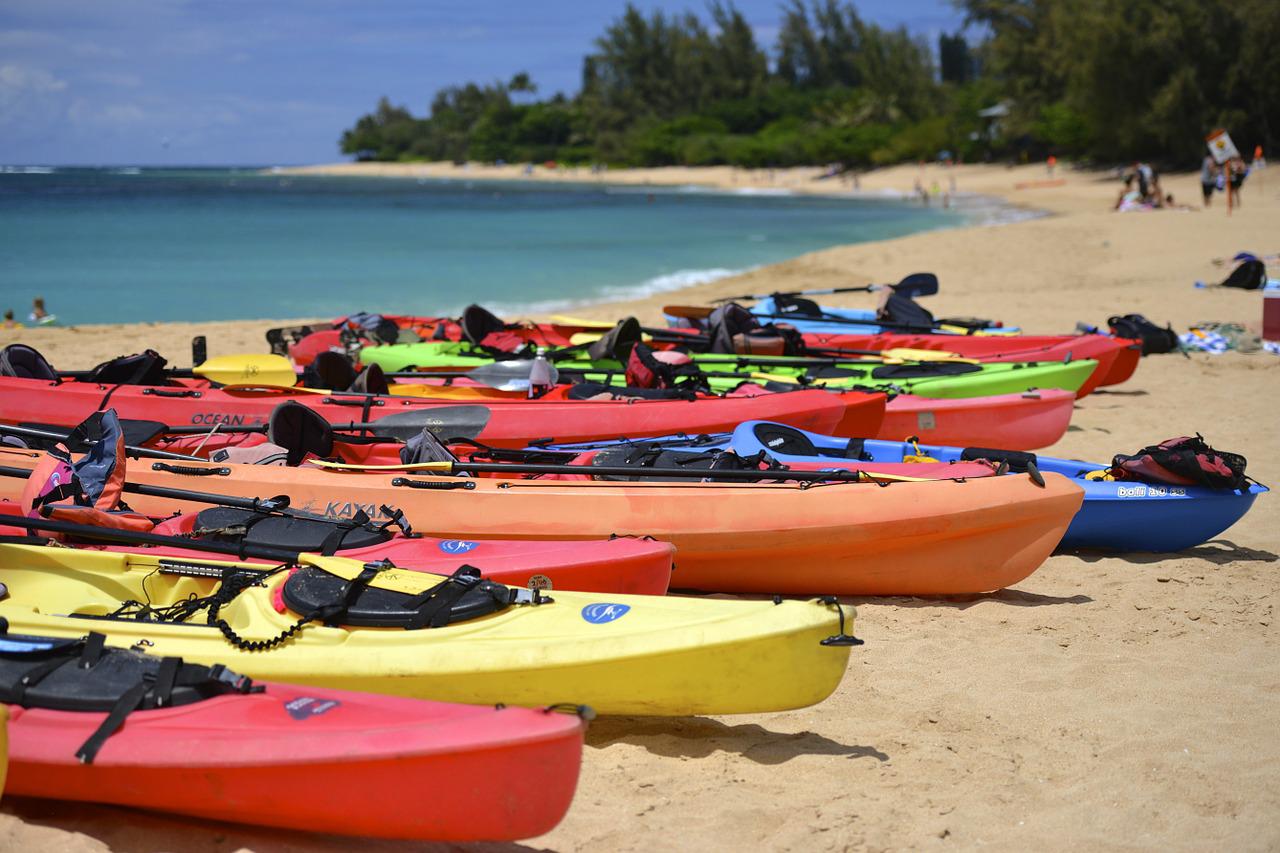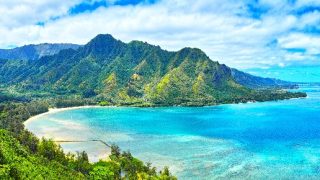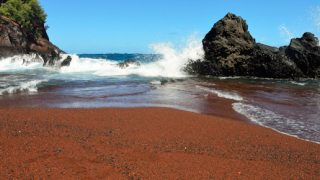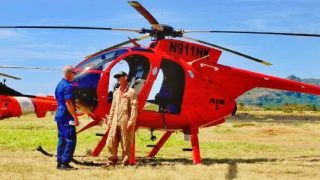More Kauai visitors have just received emergency helicopter airlifts on Kauai. On Thursday, a visitor from California, 32 years old, was evacuated from the Kalalau Trail at Haena State Park due to an injured knee. As is traditional, he was evacuated to Princeville Airport, where an ambulance met the helicopter. While offered transportation to the hospital, the man declined any further assistance. This is after the expense to Kauai for air transport, ambulance, and personnel. Who should pay?
A week ago Sunday, another similar issue was on the same trail. Three hikers were rescued when inclement winter weather and washed-out trail conditions led to another Air 1 helicopter assist. In that case, the three were transported to Hanakapiai Beach and continued their hike. Who should pay?
Also, a California hiker was rescued from the same trail last month. In that case, the man, with unknown injuries, received a helicopter evacuation to Princeville Airport and was then transported to Lihue for emergency room treatment. And right before that incident, there was another air rescue not far away when a female Utah visitor, age 53, jumped from a rope in Kapaa, was injured, and required air evacuation. Who should pay?
So far, since January, there have been at least 10 Kauai air rescues and countless ground rescues.
State readies pay for rescue Bill.
Hawaii’s legislature seems determined this time to pass at least some bill to make hikers pay for their rescues. The current bill moving forward, unfortunately, only relates to rescues from trails where visitors are trespassing and where there are signs posted.
Many say this doesn’t go far enough, or as far as other states requiring that hikers obtain paid insurance for such rescues. Some feel like this is at least a start in protecting hikers and eliminating wasted resources needed elsewhere.
Some, however, including the Honolulu Police Department, are concerned that this would prevent some people from seeking emergency help when needed. Others, including the president of the HI Fire Fighters Assn. spoke in favor of the measure.
Despite any concerns, the bill has just passed the Finance Committee with unanimous approval. A system will be required to assess fines against these hikers if passed.
This is a statewide problem.
We’ve written previously about the Haiku stairs rescues on Oahu. The long-closed, still famous stairway has reportedly seen 188 people rescued since 2010. Last month, the Honolulu Fire Department deployed nearly 20 personnel in six units, including a rescue helicopter, to provide emergency help for three illegal hikers following injury. Partly to blame are social media posts showing people hiking and people wanting the exact Instagram moment.
Why are there so many rescues at the Kalalau Trail, and how to avoid them?
- Not following warning notices or trail closure signs during inclement weather like heavy rain can put you at risk for injury and rescue. If you travel during rainy months, you must be prepared for closures and a sudden change in plans.
- Ensure you are in condition, have proper footwear, and can handle heights before doing the entire trail. Even going as far as Hanakapiai can be thrilling and spectacular.
- Join the Kalalau Trail Facebook Group. It’s current and has updates from hikers about their experiences, including those who turned back.
- Stay current by looking at the state website for Napali State Wilderness Park. The website will advise you of closures and the permit required by advance reservation if you plan to hike beyond Hanakapiai Beach.







This has to be one of my all time favority trails, beautiful, magical and treacherous.
I don’t live on Kauai, but visit frequently. I believe in treating the island and particularly the hiking trails with respect. Pack out whatever you pack in, read up on the current conditions inclusive of weather and be prepared. I’ve probably visited the trail over 20 times, but I’ve only gone to the beach or the falls, as I’m typically by myself. There are always plenty of people around, that have no business hiking there, (unprepared physically or not wearing proper attire). If you have to be assisted and airlifted out, it should be at your cost.
I’ve hiked and camped at Kalalau Beach a couple times, planning another trip there this Fall.
I would rather crawl on my hands and knees the entire 11 miles back than pay for a ride.
When people get the permit they should include life flight for like $10 bucks
I was just going to say this. In the state of California if you are hiking in an area that you may need rescued, you have pay for a permit, and show proof of insurance that pays for all these cost (Helicopter, Search & Rescue, Ambulance…etc). Hawaii should do the same.
Bryon B what are you talking about. I know of no such law in CA. Also, where are these areas that “you may need rescue” you talk about? I live 20 miles from one national park, three national forest and a large expansion of BLM land and the park would be the only one I need any kind of back country permit for.
I live in California and the only hiker insurance you can get, or have to get, is voluntary hiker insurance. None is required. Even if doing the PCT it’s not required. We have to pay for a permit to park in forests, but that’s about it. There are wilderness permits, but again it doesn’t require insurance. People just have to pay for their rescues here. Aloha.
It seems that, the permit system rightfully in place, visitors that scored a hiking permit and travelled from far away will take chances that any reasonable person would avoid (torrential rain, not being fit enough or prepared for Kalalau’s dangers, etc) and end up needing rescue. This is similar to people scoring long-sought permits to climb Denali or Everest: It’s their once-in-a-lifetime opportunity and torpedos be damned. I’m personally fine with others taking these risks – but the cost of rescue should not be borne by society. It is their personal choice and they should bear the costs of the consequences of their actions.
I was 36 and in great shape on my 1st attempt at the the Kalalau Trail. It took 2 hours to get to Hanakapiai Beach and we didnt start early enough and didn’t have the right equipment or supplies so we turned back. About 10 years later we trained, brought all the right stuff, still took all day to get to the falls and back. Challenging and beautiful trail. Make sure you are prepared. It’s worth it.
My sister and I were rescued by helicopter at Kalalau Beach in February 1976. We camped on the beach by the waterfall and nobody was on that beach for the week we were there. After 2 sunny spectacular days, the torrential February rains made the trail impassable. We ran out of food and everything we brought was soaked. We feared going into Kalalau valley for fruit as the pot growers didn’t take kindly to strangers. King Kong was being filmed on Honopu Beach, one cove over. Desperate, after days of cold and hunger, we stomped a huge SOS in the sand and at the end of the day a big cargo chopper with film crew landed and scooped us up! Extreme winds made for a violent ride to Hanalei. The entire adventure was truly a surreal experience!
I’m fully in favor of mandatory permits and insurance for all places that see regular emergency rescues.
And some laws with teeth in them for trespassing and illegal entry.
I’m against caveat charging for emergency services because that’s what they are for, emergencies.
But when people ignore precautions and get themselves in a situation, you bet they should pay. Any new laws should say just that.
Definitely agree with restitution. Hope they pass it.
For those advocating to charge tourists differently I’d point out again, public safety is paid for by property taxes. In the case of residents vs. tourists, while locals pay 100% of their own property tax bill, tourists pay a portion of the resort, hotel or rental properties tax commensurate with their length of stay. Locals who Homestead on Kauai pay just $3.05/$1000 assessed value, $6.05 without the Homestead, while vacation rentals pay $9.85/$1000 and hotels and resorts paying $10.85/$1000. And I’m sure the assessments on most resorts is very high by comparison per sqft. So even when tax dollars for the bill tourists are paying at least their fair share, and likely far more. Anyone who is found to be breaking any laws should be fined.
My point is everyone should be charged based on whatever rules or laws, not tourists vs. locals. Tourists do pay for the same the same services via taxes that resort properties and rentals pay. The taxes raised to fund public safety are generally from property taxes, which tourists pay as part of their nightly accomodation taxes. Without paying customers the rentals wouldn’t be paying their taxes which I’m sure is the greater share of many public services in Hawaii. And most EMS systems do bill for all patient transports and insurance covers whatever share they cover and the patient owes the rest. If an air rescue unit doesn’t bill for this service then it’s just tax funded.
Just speculation, but maybe the reason the guy with the knee injury didn’t want the ambulance to hospital is because of cost. Ambulance rides are notoriously expensive. If he wrecked hi knee in some way that he could not hike out on the trial, then he’s stuck with the helicopter rescue (the rest of you can argue about who pays). But did he ask for the ambulance, or did the emergency response team just order one anyway? Probably he was hiking with others who walked out and drove to the PV airport to meet him.
My did that’s going to school at HPU, got in a accident, We have insurance but the Ambulance billed my insurance $1400 for less then 2 mile trip..
My brother that lives in Tahoe, Was blind sided skying, Had to get airlifted to Reno,He had insurance for airlifting out, but come to find out there is 2 companies that airlift out of Tahoe and the wrong one picked him up, that bill 45k.
On the mainland, if a hiker or anyone else needs airlifted….there is a charge as it is for an ambulance ride. Why should Hawaii bear the cost when other states don’t? When these services are sent to a site, that service is out of commission for a coinciding incident. So the hiker gets off free of charge but the local gets the bill if they need the same service, regardless of the reason…….and in the end, the taxpayer pays the bill….
The local won’t get a bill if the helicopter doesn’t bill everyone. Transporting EMS units cannot bill some and not others, it’s all or nothing. Locals foot the bill through property taxes, which visitors pay when they rent units, as the rental property or hotel pays taxes that also pay for EMS or Fire/rescue. This is why typically hikers or other adventure seekers are fined, not billed, when they are violating laws or park rules, anywhere in the country. It is unlawful for medical transport services to have arbitrary rules on billing. Sure, lots of towns and cities have tried to bill non-residents but can be cut off from any Medicare reimbursement for illegal practices.
On the mainland whare I live (CA),medical helicopters charge but CA. Hwy Patrol and CAL Fire helicopters don’t because they are founded with tax dollars. Big difference between private and public air resources.
The helicopter in this article is a publicly founded piece of equipment so the victims tax dollars already paid.
We have made a visit to Kalalau trail a standard highlight of our Kauai vacations. I’m not sure what they are doing with the fee they now collect to visit the area but it seems a logical source of funds to offset these expenses.
I sat at the bottom of the Kalalau trail one day a few years ago waiting for friends walking down the beach, and watched numerous people start up the trail in flip-flops ! Would it be possible to have a ranger or someone at the bottom, making sure hikers had appropriate footwear and water ?
Kitty – I’ve hiked that trail at least a hundred times over the past 20 years, including a few dozen times all the way out to Kalalau Valley. I’ve seen it all. sandals, barefoot, topless women, old naked leathery barefoot guys. You name it. People hike the trail at night. There was (probably still is) dozens of non-permitted “residents” living out in the Valley. And, plenty of people killed or otherwise needing rescues, including island residents, although sometimes recent transplants who don’t understand you do not try to cross brown water at any of the three main streams. What I have never seen on the trail is a park ranger.
Charging for helicopter transport and ambulance transport in case of injury doesn’t seem unreasonable. If a patient in my state requires helicopter or ambulance transport, they are charged. Sometimes it is covered by insurance but sometimes it is not.
A rescue of otherwise “well” hikers who followed the rules but got caught in an unexpected bad situation is a bit more “gray” but if they are trespassing then the situation is clear that they should pay. Perhaps this money could be used to improve signage and barriers to prevent future accidents. Or hire people to monitor these areas to keep people out ( and I know hiring is tough is Hawaii because of cost of living and money like this seems to disappear into the abyss)
Never hiked the trail in Kauai but many on other islands. I live in Arizona. Work on the Havasupai reservation down at the bottom of the grand canyon. Havasu Falls?? Almost every year there are at least 5 rescues with hikers going deep into the canyon and falling or twisting an ankle. Some hurt much worse. Only way to bring them out is a helicopter rescue. The tourist absolutely has to pay for that rescue. Last summer I was at Slide Rock Park in Sedona with my granddaughters. So slippery. I fell,Crack my head open on the rocks. Had an paramedic ride out of that canyon and ambulance to nearest hospital. I had to pay for everything they did plus the ambulance and of course the hospital.The Tourist should definitely be responsible.
No, these people should not be charged. Many unknowing visitors don’t really understand the terrain and climate conditions until they are in trouble. I wouldn’t want the cost to deter them to call for rescue when in need. Now, if they ignore do not trespass signs or other signs speaking of the dangers, then maybe yes, charge them.
My suggestion is to make Insurance that covers ems and recovery mandatory when using Local, State and Federal Lands. Failure to insure would result in a fine on top of full recovery fees. People accept the need for Motor Insurance, for Travel Insurance and Medical Insurance.
Why is this site all about ripping on tourist and everything they do wrong? Has a local been air lifted in this time period? There is no Aloha in Hawaii for tourists anymore
Whenever American Tourists get hurt in a foreign country and have to be airlifted and they don’t have insurance, they face real world consequences of being detained or imprisoned if they don’t pay up. Having insurance or paying for services rendered is fair and equitable for all who are impacted. This is the policy in many other states, where they Will send a bill, typically when those who knowingly break the laws, rules and disregard warnings. This is not about being a Good Samaritan: this have everything about reckless individuals harming others.
Many states are considering these rescue charges as well as law breakers who interfere with marine life and other natural resources. This is happening across the board, get used to it.
If they use a helicopter or ambulance they need to pay for it. It should not be Kauai’s responsibility.
I Love (!) the compassionate and humanitarian comments which prove empathy for people (Humans!) who are in need and danger…but indeed, I expect to be charged for ambulance and other services, therefore I for one do take as much extra care as I can when doing activities. I also don’t want to put the rescuers/EMS at risk by risky behavior. That said, I like to enjoy my hikes/exercise, as others do and hope I everyone understands both sides to this issue. Mahalo for the love.